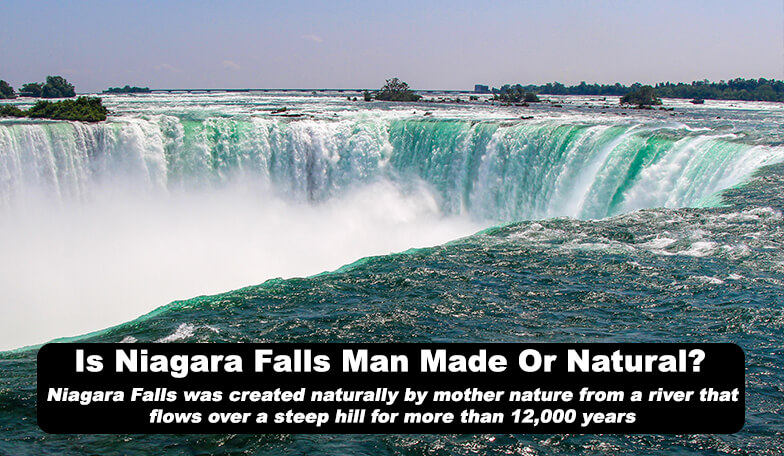Niagara Falls is one of the most famous natural attractions in the world, drawing millions of visitors each year to witness the awe-inspiring sight of water cascading over the Niagara Escarpment. But is Niagara Falls truly a natural wonder, or has it been artificially created by humans?
Table of Contents

The short answer is that Niagara Falls is definitely a natural attraction. The Niagara River, which flows from Lake Erie to Lake Ontario, has been carving out the Niagara Escarpment for thousands of years. As the river flowed over the soft shale and sandstone of the escarpment, it slowly but surely chiseled away at the rock, creating the three distinct waterfalls that we know today as Niagara Falls.
There is no doubt that humans have played a role in shaping the Niagara Falls landscape. For centuries, the local indigenous population used the Niagara River as a source of fresh water and fish. European settlers arrived in the area in the late 1700s and quickly realized the potential of the falls as a source of hydroelectric power. They built several hydroelectric dams on the Niagara River, including the Niagara Falls Power Company and the Robert Moses Niagara Hydroelectric Power Station.
These dams have had a significant impact on the flow of water over the falls. Today, the majority of the water that flows over Niagara Falls is diverted to power turbines, leaving only a small fraction of the water to flow over the falls themselves. This has led some people to claim that Niagara Falls is a “man-made” attraction, but this is not entirely true. The falls themselves are still natural, and the water that flows over them is still the same water that has been carving out the Niagara Escarpment for thousands of years.
Another human influence on the falls is the construction of the Niagara Parks Commission. The Niagara Parks Commission is a government agency that was established in 1885 to preserve the natural beauty of Niagara Falls and promote it as a tourist destination. The commission has made a number of improvements to the area around the falls, including the construction of observation decks, walking trails, and other amenities.
How Old is Niagara Falls?
The Niagara Falls is a relatively young geological formation, estimated to be around 12,000 years old. The falls formed as a result of the retreat of glaciers from the Niagara region at the end of the last Ice Age. As the glaciers melted and receded, they created a large lake called Lake Iroquois which filled the area that is now the Great Lakes. When the water levels in the lake dropped, the Niagara River was created, and it began to flow over the Niagara Escarpment, cutting into the rock and forming the falls.
It’s important to note that the Niagara Falls is not a static formation, and it continues to change over time. The erosion caused by the river’s flow continues to shape the falls, and the rate of erosion can vary depending on factors such as water flow, weather, and rock type.
It’s worth noting that the Niagara River is not only responsible for the creation of Niagara falls but also for the shaping of the Niagara Gorge, the riverbed downstream of the falls. The Niagara Gorge is an 11-mile long and up to 700 feet deep chasm, it is also relatively young, estimated to be around 7,000 years old
The Formation of Niagara Falls
Niagara Falls was formed by the erosion of the Niagara Escarpment over thousands of years. The process began at the end of the last Ice Age, around 12,000 years ago, when glaciers retreated from the Niagara region. As the glaciers melted and receded, they created a large lake called Lake Iroquois which filled the area that is now the Great Lakes.
As the water levels in Lake Iroquois dropped, the Niagara River was created, flowing out of Lake Erie and into Lake Ontario. The river began to flow over the Niagara Escarpment, a layer of hard dolostone rock that was more resistant to erosion than the surrounding shale and sandstone. As the river flowed over the escarpment, it cut into the rock, creating a chasm that would become the Niagara Gorge.
The erosion of the escarpment created three distinct waterfalls: Horseshoe Falls, American Falls, and Bridal Veil Falls. The Horseshoe Falls is the largest and most famous of the three, and it is located on the Canadian side of the Niagara River. The American Falls and Bridal Veil Falls are located on the American side of the river.
The process of erosion at Niagara Falls is ongoing, and the falls continue to change over time. The rate of erosion can vary depending on factors such as water flow, weather, and rock type. However, the rate of erosion is generally slow, and it is estimated that the falls will retreat upstream at a rate of about 1 foot per year.
It’s worth noting that the Niagara River is not only responsible for the creation of Niagara Falls but also for the shaping of the Niagara Gorge, the riverbed downstream of the falls. The Niagara Gorge is an 11-mile long and up to 700 feet deep chasm, it is also relatively young, estimated to be around 7,000 years old.
Conclusion
In conclusion, while humans have certainly played a role in shaping the Niagara Falls landscape, it is still a natural wonder that has been formed by the erosion of the Niagara Escarpment over thousands of years. The hydroelectric dams and other human interventions have certainly impacted the flow of water over the falls, but the falls themselves remain a natural marvel that continues to awe visitors from around the world.
